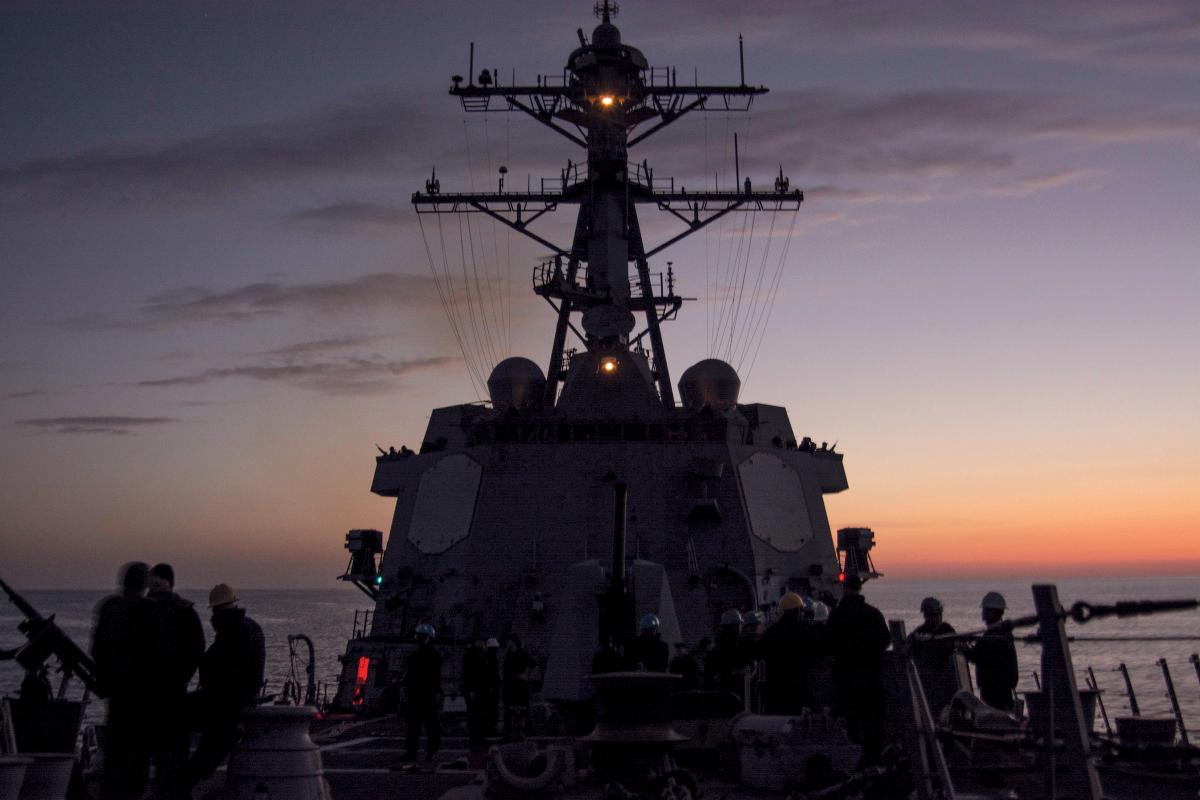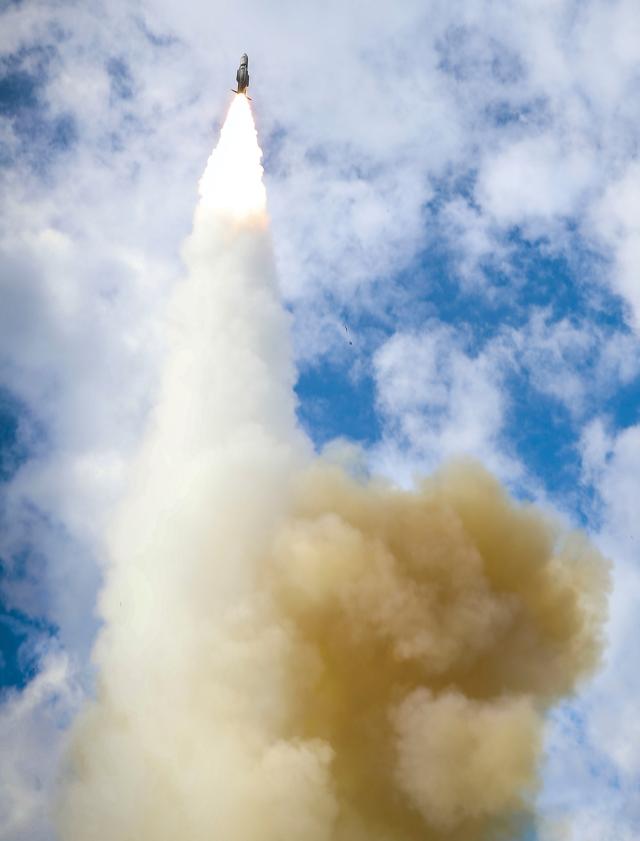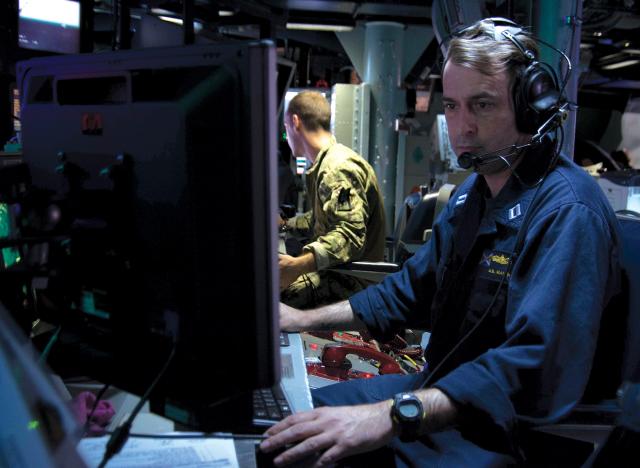Leaders are not given teams; they build them. History and experience are reminders that our teams must always be ready, as the enemy can strike when least expected. The strength and toughness to achieve victory under fire must be forged in crews long before the enemy fires their weapons. Combat success depends on months of intense preparation to ingrain tactical muscle memory combined with engaged leaders to mold an environment of respect and unity. These are the lessons I learned firsthand on board the USS Mason (DDG-87) on a fair October night in the waters of the Red Sea.
Open bridge-wing hatches on the Mason drew in the warm fall breeze off the Red Sea to break the thick, stagnant, evening air. The Mason’s sailors enjoyed a respite from the intense daytime heat. As the smell of the sea drifted onto the dark bridge, I focused on my responsibilities as the junior officer of the deck. Our watch team worked diligently to provide course and speed recommendations to the officer of the deck, as we made certain the Mason remained positioned to provide effective screen coverage for another ship in our company. The watch team monitored our companion’s navigation lights ahead as they bounced with the motion of the sea.
This night was like hundreds of other nights I had stood watch on a deployed vessel. Then, suddenly, in the quiet of that Red Sea night, three words passed over the combat information center network would change the remainder of the deployment and shape my understanding of wartime readiness and combat leadership.
“Vampire, Vampire, Vampire,” the tactical action officer calmly yet boldly, passed over the net, indicating a threat missile attack. In those fleeting moments, another routine day on deployment instantly turned into an all-hands effort to defend against antiship cruise missiles fired toward the Mason and our fellow U.S. ships. Without hesitation, the supporting watchstanders gave their reports to the tactical action officer in the same manner they were delivered mere seconds before: calm, bold, and concise. The fluidity of their responses was exactly as we had rehearsed during countless training evolutions and drills. On this night, the Mason was prepared, and the tactical action officer did his job and set the tone for every event that followed.
Thrust into naval combat instantly and unexpectedly, the Mason crew’s toughness and readiness to fight were greatly tested. Crewmembers had become accustomed to the high-tempo tasking in the three months since leaving Norfolk, and those experiences helped sharpen the warfighting skills of all on board. This readiness proved to be instrumental. When the dust settled, it became clear that the Mason had mounted an effective defense, as each ship in company survived the missile attack unscathed. It was strength and training that underpinned the Mason’s ability to prevail. It reminded the crew of the Latin phrase, fortuna favet fortibus—fortune favors the bold.
Teamwork Strengthens
Since the attack in the Red Sea, I have been able to look back on those events and reflect on how the experience shaped my growth as a leader and warfighter. Just a few days prior to the attacks, the captain had pinned on my lieutenant bars, making me the most senior junior officer of the deck on board the ship. This did not dampen my pride or my spirit, because in a few weeks I would stand for my final board for officer of the deck. Unlike surface warfare officers, there is no requirement for members of the cryptologic warfare community to earn an officer of the deck designation letter, but my desire to fully integrate into the wardroom and gain deeper insight into naval warfare fueled my pursuit of this qualification and allowed me to be a valuable team member when the ship found herself under fire.
Playing a role in the events that unfolded while standing junior officer of the deck reminded me of a fundamental and critical principle of winning wars: teamwork. In the plan of the day the day prior to the first antiship cruise missile attack on the Mason, the executive officer fortuitously quoted a stanza from Admiral Herbert G. Hopwood’s famous poem, “The Laws of the Navy”:
On the strength of one link in
the cable,
Dependeth the might of the chain.
Who knows when thou may’st
be tested?
So live that thou bearest the strain!
To bear such strain in the modern Navy, however, leaders must engender mutual respect to bring together a diverse workforce that truly reflects the rich makeup of the United States. To meet this challenge, teams must harness and celebrate their unique differences while fostering an environment of trust and inclusivity. Engaging with every person to produce creative solutions is key. Each service member must truly feel and be part of the warfighting team. The positive attributes of this environment allow the Sea Services to take on difficult challenges and to capture different perspectives and insights that may never have been achieved without diversity.
Leaders must also accept that a lone link, however strong, does not create a strong chain. It is all too easy for leaders to rely on top performers to carry most of the workload during peacetime operations. The speed of combat, however, will not afford them this luxury, as reliance on the “A” team degrades the overall warfighting readiness of a ship.
On that night in the Red Sea, each member of the crew on watch instantly became a critical link to defend the Mason and the ships in her company. It proved that when the enemy strikes, leaders cannot hand-pick the team on watch, and no single warrior can do it all. Optimization for warfighting relies on an equal distribution of workload, while holding all personnel accountable for the quality of their output. Every link must be strengthened and toughened by training to handle the full range of contingencies.
Resiliency Toughens
More than three decades had passed since the last U.S. warship had been fired on by enemy missiles when the Mason and the ships in her company found themselves under fire. When the USS Stark (FFG-31) was attacked in 1987, most of the sailors serving on board the Mason had not yet been born. The Mason’s experience with an unexpected attack demonstrates why leaders must ensure sailors know that at any moment, day or night, they may be called on to fight.
The Navy’s greatest core competency and highest priority should be to prepare sailors not just to meet but to exceed warfighting requirements. This goal is much easier said than done. Administrative burdens, collateral duties, and day-to-day tasks can easily detract from a leader’s ability to place warfighting first. In The Art of War, Sun Tzu writes, “If you know the enemy and know yourself, you need not fear the result of a hundred battles.” Diversions from the primary objective of warfighting can and will distract sailors from developing their warfighting acumen.
Warfighting and peacetime objectives require a delicate balance. Non-warfighting activities offer positive contributions to the greater good of military operations and should not be undervalued. The military’s ability to ensure maritime dominance hinges on the skill of leaders to meet peacetime requirements while sharpening their primary focus on winning wars. Successfully bridging the gap between each service member’s duty and assignments and his or her impact on warfighting effectiveness is critical. Allowing teams to lose warfighting focus can be detrimental to victory and could cost lives in combat when it matters most. Whether providing support to military operations, afloat in a tactical role, or deployed on land, all personnel must know how their duties will impact the mission.
Displays of strength and toughness—in situations such as the one faced by the Mason—are grounded in resiliency. The Mason’s resiliency was built on a thorough and dedicated approach to training that pushed all watchstanders to excel. Just as the tactical operations officer set the tone of battle with a calm and bold demeanor when the Mason was attacked, leaders at every level drove the train-to-fight mentality among their sailors. Full optimization of training begins with the attitude of leadership and ends with the level of effort each team member contributes to the training objectives.
Training Triumphs
Leaders must instill ownership and demand accountability of the entire training process, from the lowest levels in a team to the most senior. Mentorship allows everyone in the team an opportunity to contribute to success. Instilling in Navy personnel a belief that the greatest accomplishment a watchstander can pursue is to successfully pass on their knowledge to a trainee creates a positive learning environment. By taking pride in their ability and ownership of the process, each team member will become a force for effective training and high levels of warfighting readiness.
The sheer volume of training, drills, and exercises required to become highly proficient technical and tactical experts has the potential to be overwhelming. We must meet this challenge by not allowing the amount of training to dull a leader’s senses to the devotion and attention required for every training evolution.
The Mason’s experience in the Red Sea demonstrates that when training is approached with a methodical and goal-driven attitude, Navy personnel will be ready when faced with combat. There will be no surprises and there will be no fear, because our men and women will have performed in the same manner countless times before. War-winning confidence is gained by a team’s knowledge that they have already done it many times before. Like the watchstanders on board the Mason, properly trained warriors will fall back instinctively on their training to perform their jobs calmly, yet boldly.
Lieutenant McKinney is a cryptological warfare officer assigned to Navy Information Operations Command, Texas, where he works in computer network operations with the 600 Combat Mission Team. A prior enlisted sonar and cryptological technician, he has deployed numerous times throughout Fifth, Sixth, and Seventh Fleet areas of responsibility. He served as the signal warfare officer on board the USS Mason (DDG-87) when her crew earned the Battle Efficiency “E,” the prestigious Battenberg Cup, and the Combat Action Ribbon for performing combat support operations in the Red Sea.





